Hey Wiki Pages and Wiki Squires, I have exciting news. Well, by a certain muted definition of exciting. Mildly intriguing news, let's go with that. I've just completed a Wiki Project that has taken nine months from start to finish. I haven't been working tirelessly on it day or night or anything, more as an occasional something to do while I listen to new Bombcast and MBMBaM podcasts, but it still required a lot of work and perseverance. Sorry, I'm making this sound like I climbed Everest or something. Let's start over:
At the start of this year, I began what seemed like a fairly simple task: Ensure that every SNES game from 1993 had a full wiki page. My definition of "full" for the purposes of this exercise included the following:
- Overview text. Most game pages ideally need an overview section (brief synopsis, basic history of releases, any pertinent facts about the game from a meta standpoint) and a gameplay section (actually gets into detail about how the game plays, its systems and features), but I kind of just left them with overviews in most cases.
- Deck. That little blurb at the top of the page that briefly describes the game. There's nothing too concrete in the rules about what that message ought to contain, but a simple single-sentence description of the game usually suffices. At least it does for my purposes.
- Screenshots. Just a smattering of gameplay shots, all the relevant box art and every title screen (for cases when a game changes its name after localization). We have an awful lot of sketchy .jpeg screenshots, unfortunately. Makes me wonder what decade they were taken in.
- Header image. The background shot, the one that goes behind the deck. This requires high-res screenshots, which is kind of a pull when you're dealing with a console that natively displays in a 320x200 resolution. Such a small image looks awful and blurry when blown up for a header image, considering most modern PC monitors use something like 1366x768 or higher as their default. It also means choosing the right shots that work well within the small target window that the site picks out for the display. We have a useful tool by mod @chaser324 that lets you "test" uploaded images, but I've gotten to the point now where I can feel it out well enough. Mostly.
- Full details. The side-panel that tells you the platforms, release date, genres, themes and so on. It's not always possible to fill out every field (especially aliases and franchises, given that they're not always applicable), but I try to ensure we have as much info as possible.
- Releases. Obviously, the game needs all its releases too. It's a database thing. Since the big site switch, there's now spaces for a developer and publisher for every release (publishers typically tend to change depending on region) so there's usually at least some work to be done here even on popular pages.
Now, the way I figured it, the Super Nintendo is one of the most popular consoles in the world. I fully expected every page to have at least half of the above already complete. I suspected I'd be filling in the occasional missing detail and adding a fancy new header image and then moving on. Yeah, that wasn't the case. Most Super Nintendo pages require a lot of work, it turned out. Even the big ones.
Because talking about old games is more fun than talking about updating the wiki pages of old games, I'm going to segue now into a list of highlights. I discovered many of these games for the first time while working on this project -- Japan's Super Famicom saw a lot more games than the US/Europe SNES ever did -- and while many are your standard baseball and mahjong nonsense, there's a few weird hidden gems in there too. I'll throw in some stats and stuff too, for flavor. You know, nothing brightens up an article like a bunch of numbers.
January
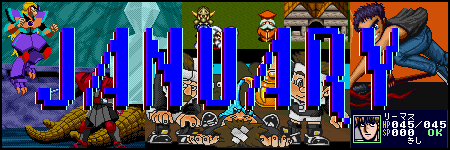
- List of releases: 16
- US Block: 2
- Japan Block: 14
- List of Super Famicom exclusives: 9
SNES highlight: The Super Nintendo release schedule of 1993 was a lot like the modern console release schedule of today: the first few months of the year were fairly mild, it picked up around Spring, became a drought in the Summer and then slowly picked up again around Autumn and continued strong until the holiday season peak. January saw an average number of releases, but it also saw a relatively small amount of games in the "US Block": those games that first appeared in the US. These include the ubiquitous Epyx sports mini-game collection California Games II (which was first released on PC three years prior, so I don't know what the delay was) and The Hunt For Red October game. Dated computer ports and mediocre license games is pretty much the US Block in a nutshell.
In most cases I'll picking a game that was released in Japan that month and saw a US release at some point later on. While they've been dislodged as world leaders in video game development in recent times, the Japanese really were the only ones producing anything of merit on consoles back in the early 90s. I realize what that sounds like, but it's more a demonstrable fact than any weeaboo protestation.
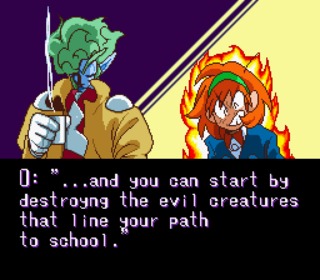
The SNES highlight for January 1993 is Makeruna! Makendou, otherwise known as Kendo Rage. While not a particularly great game (slim pickings this month, I assure you), Kendo Rage is interesting because the localization team was asked to take something so incredibly Japanese as a sentai Japanese schoolgirl with a katana and make it more "American". Unlike many other Western makeovers, there wasn't much that ended up changed, and the game is still as anime as two Gundams surreptitiously rendezvousing under a cherry blossom tree. If nothing else, it demonstrated a hope that intensely Japanese games would be given more chances overseas, and many of the most memorable Super Nintendo games were those so unashamedly Japanese that they stayed with you.
SFC highlight: The Super Famicom highlight, of the nine games that never (officially) left the Land of the Rising Sun, is Elfaria. Though it seems like a (El)fairly(a) standard JRPG, perhaps one that was never quite good enough to see a localization, I was amazed at the artwork when taking screenshots for it. Created by Susumu Matsushita, it reminds me of the European comics I used to read as a kid, like Goscinny/Uderzo's Astérix. I'd hazard a guess that much of the in-game artwork had a similar style. When Enix hired manga artist Akira Toriyama (he of Dragon Ball fame) to work on the character and monster designs of Dragon Quest, other developers saw his involvement as one of the many X-factors that made Dragon Quest so successful. As well as copying its first-person turn-based combat and other mechanics, JRPG developers would also frequently hire prominent artists from other fields (manga, anime) to give their own game a distinctive art style.
February
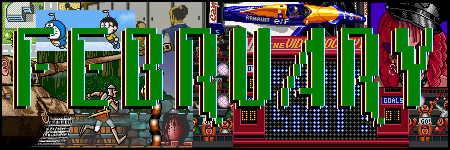
- List of releases: 18
- US Block: 3
- Japan Block: 15
- List of Super Famicom exclusives: 10
SNES highlights: The easy standout of February 1993 is Star Fox, the first entry into the 3D polygonal on-rails anthropomorphic animal space-sim series from Nintendo themselves. Nintendo actually sought outside help from UK developer Argonaut Games, which had created a polygonal shooter for Nintendo the previous year (1992's X) and were best known for their Starglider series.
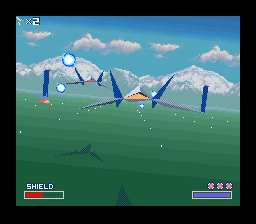
Star Fox is the first game to use the Super FX chip, famously, and would lead the charge for a smattering of polygonal games for the system. Of course, it wouldn't be until the next generation of consoles when polygonal graphics would become the norm, but SNES developers were never one to shy away from exploiting the system's limited tools to create 3D-ish presentations. It was the sprite-scaling Mode 7 that got the most use, and pre-rendered 3D models after that. Sneaky stuff.
Honorable mentions: SimAnt, which failed to make the splash SimCity did for the SNES, despite having the more interesting premise. The US Block games were Cool World (based on that "adult" Roger Rabbit movie starring Brad Pitt), Harley's Humongous Adventure (I shudder to think how many SNES platformers used the cliché of micro-sized protagonists walking through normal households) and Hit the Ice (a parody ice hockey game, because that's a sport everyone takes too seriously).
SFC highlights: The SFC stand out is Gegege no Kitarou: Fukkatsu! Tenma Daiou. The Japanese tended to fall into the similar trap of putting development speed over quality when it came to their licensed games, but Gegege no KItarou: Fukkatsu! Tenma Daiou -- based on the Gegege no Kitarou manga/anime about a yokai (spirit) boy who helps humans by fighting the worst the underworld has to offer -- is a visually arresting, challenging boss rush in the vein of something like Treasure's Alien Soldier. Boss characters seem to pop out around every corner, and many have interesting patterns or are so damn bizarre that it throws you for a loop. I saw most of what the game had to offer thanks to an episode of hit Japanese LP TV show GameCenter CX. It didn't get any less crazy after that first encounter with a giant blob with a dude's face on it.
Honorable mentions: Leading Company, a corporate life sim where the 80s still rule supreme. Can you make your rival businessmen destitute before it's time for your liquid lunch? How much more tastefully off-white can you make your embossed business card? Are those Huey Lewis MIDIs on the soundtrack? Also: Wally o Sagase!, where you literally (well, in-game) meet Waldo's maker in a metaphysical take on the world's favorite hidden person picture puzzle franchise.
March
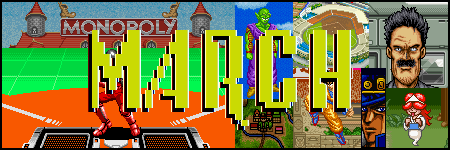
- List of releases: 31
- US Block: 2
- Japan Block: 29
- List of Super Famicom exclusives: 14
SNES highlights: March was a busy month with thirty one releases, and the best SNES game of the lot is probably Ogre Battle: The March of the Black Queen. A Squaresoft joint, the game combines the turn-based RPGs the company was known for with a tactical real-time war sim, where troops would slowly march towards their destinations as you attempted to out-maneuver the enemy forces. It's all about choosing whether to stack one squad with your best units and hoping they trample everything in their way, or spreading the units around for equal growth and minimal casualties.
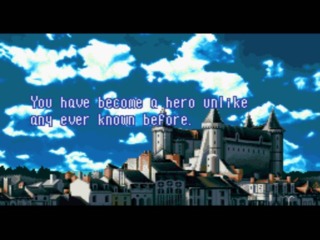
The game was actually a semi-serious spin on Square's parody series Hanjuku Eiyuu. They presumably felt that the very Japanese comedy stylings wouldn't work as well overseas as a traditional Fire Emblem-y/LOTR fantasy warfare scenario.
Honorable mentions: Also released in March of 1993 was Chou Makai Taisen: Dorabocchan, best known to us as The Twisted Tales of Spike McFang. it's a top-down third-person shooter similar to Pocky and Rocky, that almost felt like a kid-friendly spin-off of the Castlevania series. In the original Japanese version, Spike apparently ate the hearts of his enemies (another allusion to Castlevania and its convention of a heart-based economy). The US version changed it to tomatoes. What is he, Count Duckula? The excellent SNES shoot 'em ups BioMetal and Pop'n Twinbee also came out this month.
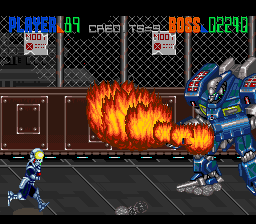
SFC highlights: There were a bunch of interesting Super Famicom exclusives this time. The one I had the most fun grabbing images for was Edo no Kiba, one of two SFC games from 1993 that could be boiled down to "anime RoboCop". Like its Sega counterpart ESWAT, the player is this cool as hell cyborg cop who rockets through dystopian NeoTokyo beating up criminals with military-grade weapons.
Honorable mentions: Ihatov Monogatari is a bizarre little adventure game that doesn't rely on conflict to tell its story, and seems to be based on the posthumously published works of a long-dead Japanese author. This Hardcore Gaming 101 article goes into more detail. Metal Max 2 seems like a badass open-world JRPG with a post-apocalyptic setting that allows you to hire your own mercenary army of Mad Max dudes in tanks and trucks. Neugier: Umi to Kaze no Koudou is a top-down action RPG with QTEs that struck me as similar to Illusion of Gaia. JoJo no Kimyou na Bouken is the first ever JoJo's Bizarre Adventure game, and is a weird mix of an adventure game and turn-based fighter RPG? I guess a confusing genre mix is apropos for that particular anime.
April
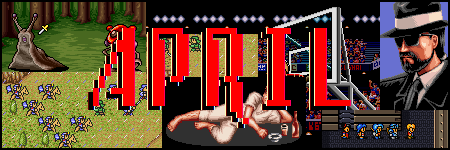
- List of releases: 19
- US Block: 7
- Japan Block: 12
- List of Super Famicom exclusives: 6
SNES highlights: We calm down a bit in April with nineteen releases, and a much larger US Block than we've had previously. There's too many promising games here to choose a highlight, but I'll go with Breath of Fire because I'm a mark for that series. Capcom's Breath of Fire games are their take on a traditional fantasy RPG, albeit one where the main character can shapeshift into a dragon. The first Breath of Fire had some great graphics, a neat isometric view for its combat and the aforementioned dragon shapeshifting was sort of a heavy metal take on the summons of Final Fantasy: a temporary boost of otherworldly power to depend on in cases of emergency.
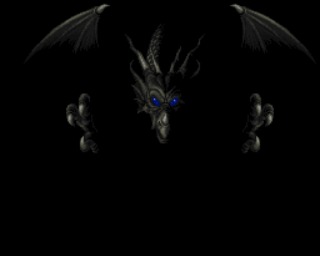
Honorable mentions: Like I said, this month seemed packed with great SNES games. Operation Logic Bomb is considered one of the best hidden gems on the system, a top-down shooter in the Metal Gear/Alien Syndrome mold with some trippy visuals in its partially-virtual cybernetic world and a bunch of novel features. Blizzard's best game, The Lost Vikings, also premiered on the system this month, as did Hudson's first super outing for their little anime Ted Kaczynski in Super Bomberman. Of course, we also got Wayne's World, Toys and American Gladiators this month too. April, she is capricious.
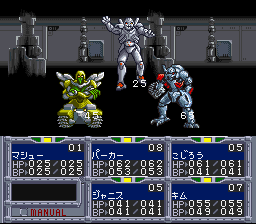
SFC highlights: I'm going to give this one to Ryuuki Heidan Danzarb, a scenario-based sci-fi RPG from Pandora Box with some unspecified help from Gainax, the creators of Neon Genesis Evangelion. I've yet to delve too far into the game's fan translation, but it seems fairly varied with its different missions, each with its different tasks to achieve. A bit like Live a Live, another fan translated RPG worth checking out for its unusual design choices.
Honorable mentions: I'll (honorably) mention this one for sheer weirdness value, Action Pachio is a Pac-Man World take on Coconuts Japan's pachinko mascot Pachio-kun. Pachio-kun had until this game only starred in pachinko sims, on a never-ending quest to procure as many of his tiny inanimate brethren as possible. What's odder is that they built the game to be more like Sonic the Hedgehog, emphasizing speed and rolling around. It didn't seem too bad, honestly.
May
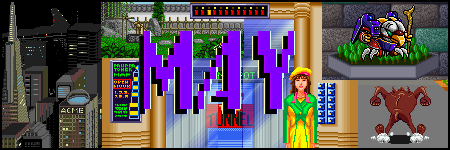
- List of releases: 13
- US Block: 8
- Japan Block: 5
- List of Super Famicom exclusives: 3
SNES highlights: The release schedule trickles to a relative crawl as Summer approaches. May is the first month where the US Block outnumbered the Japan Block. Still, for as few games as there were, there's still a few good picks here. My favorite would have to be the Super Nintendo adaptation of Shadowrun, a complex isometric RPG that you didn't see too often on consoles. It pre-dates the Infinity Engine series, even, making it very impressive indeed. The player had a few options when it came to upgrading their decker hero Jake Armitage, and the game required you be smart about things to avoid falling into its many pitfalls.
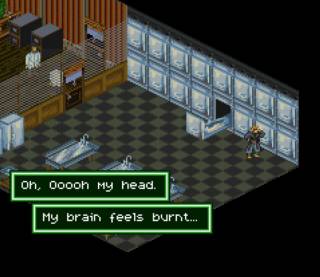
That it would go on to inspire the recent Shadowrun Returns (which includes an extended cameo from Jake) is a testament to how ahead of its time it was.
Honorable mentions: There's the console-exclusive sequel Final Fight 2, which drops Cody and Guy from the roster but at least keeps the important one; there's Super Turrican, the appeal of which continues to be lost on most Americans (not that I know either. It's the soundtrack, I think); and there's also Bubsy in: Claws Encounters of the Furred Kind, which I just put here as a joke. The actual third honorable mention is Titanic simulator SOS (a.k.a. Septentrion), just one of many odd experiments Human Entertainment developed during their time. It's brutally difficult, rewarding repeated playthroughs as you gradually figure out where to go in the limited amount of time the game gives you to escape a sinking cruise ship. It also made for a pretty good GameCenter CX episode.
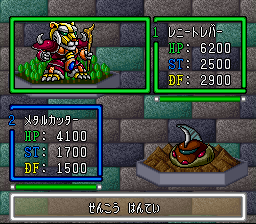
SFC highlights: Of the three Super Famicom exclusives this month, my hands are kind of tied with the highlight: Conveni Wars Barcode Battler Senki: Super Senshi Shutsugeki Seyo!. This sesquipedalian strategy RPG was the first SFC game to be compatible with the Barcode Battler toy, via a peripheral you could plug into a controller port. It's kind of neat to have a video game turn the barcodes you find on groceries into units for a strategy RPG thing, even if the game itself doesn't seem too hot. Kinda like those Monster Rancher games and CDs. Considering the only other two options were a Go game and a pachinko game, there's not much of a contest.
June
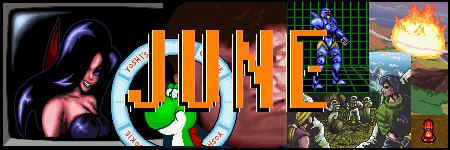
- List of releases: 26
- US Block: 13
- Japan Block: 13
- List of Super Famicom exclusives: 10
SNES highlights: I might've said the Summers were quieter. I lied. There were twenty six new games in June, which is the second largest amount of the year so far. This is due to both US and Japan Blocks going at full speed to draw in all the kids who don't like to go outside during the warmer months, I'd assume.
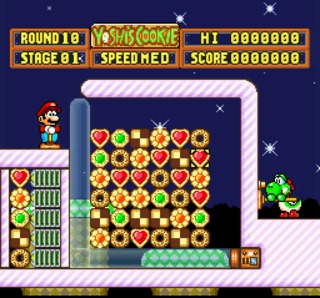
The SNES highlight this time is Yoshi's Cookie, because Yoshi gets too much shade thrown at him around here and Cookie is a deceptively addictive puzzle game.
Honorable mentions: Plenty to choose from here as well. Lufia & The Fortress of Doom (Estpolis Denki) isn't much compared to its sequel, but was appealing due to its cartoony artwork and simple mechanics in a time when JRPGs were finding early success in the wake of Final Fantasy IV (the JRPG localizations prior to FF4 were kind of niche. And now JRPGS are niche again, I suppose). Run Saber is a goofy, enjoyable action game that borrows more than a few pages from Strider's book with its acrobatics. Battletoads in Battlemaniacs is the best looking Battletoads game, if you're one of a Rare breed actually fond of that sadistic series.
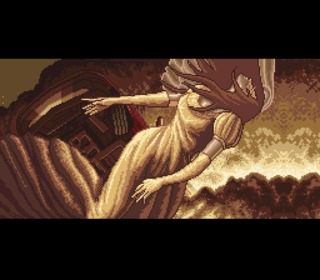
SFC highlights: Maybe it's not the greatest game, but for premise alone it's gotta be Gekitotsu Dangan Jidousha Kessen: Battle Mobile. In the near future, Mad Max-ian road bandits kill the wife of a newlywed couple on their honeymoon. The guy spends the next year souping up a red Interceptor, fills it with weapons and takes on the gang's leaders in a Spy Hunter-inspired vehicular combat game. The Japanese-fluent @pepsiman and the barely English-fluent Mento tried to decipher its word salad title and could only come up with "Breakthrough Bullet: Final Car Fight: Battle Mobile". Now, that's a title!
Honorable mentions: Props go out to Dragon Slayer: Eiyuu Densetsu II, the "lost" Legend of Heroes sequel that remains one of the few older games in the series to never see an English localization. Cosmo Police Galivan II: Arrow of Justice is both the other anime RoboCop game I talked about and the runner-up for best title this month. It's a more standard side-scrolling brawler than Edo no Kiba, which had you moving at incredible speeds with your jet boots taking down biker gangs.
July
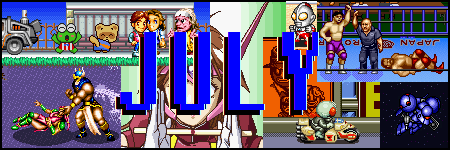
- List of releases: 28
- US Block: 2
- Japan Block: 26
- List of Super Famicom exclusives: 14
SNES highlights: I have no idea what to tell you. Maybe Japan takes summers more seriously than we do, because the vast majority of the games released this month were in Japan. It's tough narrowing down a SNES highlight with that kind of traffic, but Super Mario All-Stars is a pretty safe bet.
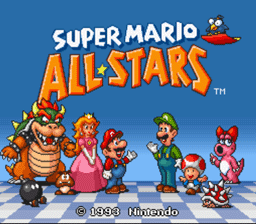
A compilation of three of the best games for the NES (and the Japanese Super Mario Bros 2, dubbed the Lost Levels here) graphically enhanced is hard to beat, after all. All-Stars would go on to be bundled with most Super Nintendos going forward, usually coupled with Super Mario World on the same cart.
Honorable mentions: Almost too many to count. The best three would be the surprisingly decent co-operative puzzle game Goof Troop; the underappreciated Rocky Rodent from Irem, who changes his hairstyle to pass through levels; and the endlessly entertaining Street Fighter II Turbo, who some might claim is the best of the early iterations of Capcom's juggernaut fighter series.

SFC highlights: While it might seem like we're spoilt for choice here, there is only one true answer: Giant Bomb favorite Sanrio World Smash Ball!. The simple joys of watching a frog and a raccoon frenetically swat a flying disc back and forth cannot be overstated, and it's always a welcome sight whenever the Bomb Squad bring it out during a slow UPF.
Honorable mentions: While Sanrio World Smash Ball! doesn't have much in the way of competition, there's still a few interesting SuFami games in that enormous pile of July releases. Death Brade is an hilariously named arena fighter known elsewhere as Mutant Fighter, sort of like a mythology-based Pit-Fighter; Dai-3-Ji Super Robot Taisen is the first of Banpresto's crossover mecha RPGs to make it to the Super Famicom; and then there's the inscrutably anime Super Back to the Future II, a Japan-exclusive platformer that looks way more fun than the awful movie license dreck we got.
August
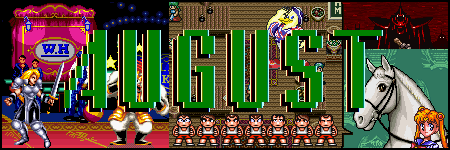
- List of releases: 15
- US Block: 0
- Japan Block: 15
- List of Super Famicom exclusives: 10
SNES highlights: Shockingly, the US didn't produce a single new game for the SNES in August, despite 1993 being one of the peak years for the console. That Summer slump in full force, I'd suspect. Japan kept us covered though, producing yet another batch of memorable titles.
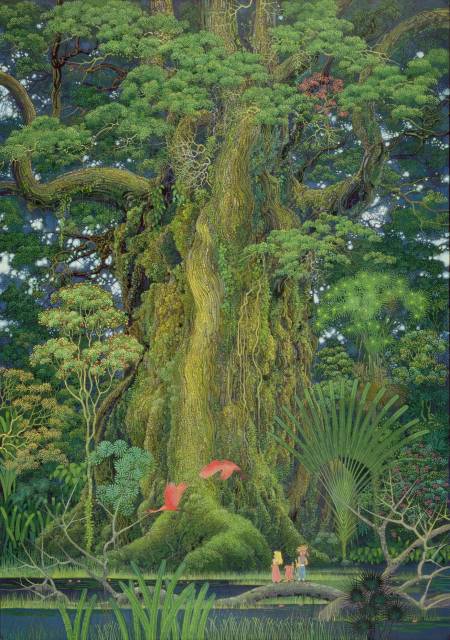
The no-doubts-whatsoever highlight of August is Seiken Densetsu II, best known as Secret of Mana. Secret of Mana was, along with Final Fantasy IV, one of the benchmark JRPGs for the system and would help launch the genre as a force to be reckoned with in the US for the remainder of the Super Nintendo's relevancy. (The PlayStation's Final Fantasy VII would launch it to even greater heights, of course, but that's neither here nor there). Secret of Mana may well be one of the greatest games ever created for the Super Nintendo; a game that could be ethereally beautiful with its affecting soundtrack, visuals and story while simultaneously one of the goofiest and baffling experiences with its chaotic three-player mode and anime idiosyncrasies. It's the game that sold me on JRPGs forever.
Honorable mentions: With only five games that ever saw US releases on the list (actually, that's a lie, there's only four: the fifth saw a single international release for France, so I couldn't count it as a Super Famicom exclusive), there's not a whole lot of options here. Super Slap Shot seems like an entirely capable ice hockey game with close-ups for its fights and Nobunaga's Ambition began an entire genre of inscrutable strategy sims based in Sengoku era Japan (the SNES game is actually the second in the series, referred to as Zenkokuban or "Whole Country Edition" in Japan). Notable as well is that French game I mentioned earlier: a brawler based on Sailor Moon. Yeah, that Sailor Moon.
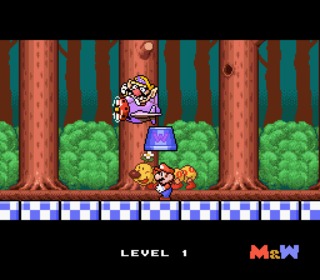
SFC highlights: The only real choice here, and perhaps the only game anyone would've heard of, is the Japan-exclusive Mario & Wario. In this mouse-driven game, Wario drops a bucket on Mario's head and the player, as a helpful fairy, has to direct him and clear his path of dangers. It's a tough game that relies on timing and mouse control, and only gets more difficult in the later stages when they stop giving you checkpoints. It's another game that made for an interesting episode of GameCenter CX.
Honorable mentions: There's honestly not much else this month. There's a couple of baseball games and a couple of horse racing games; two genres that seem to make up most of the Super Famicom exclusives. Jutei Senki is a curious take on a Fire Emblem style strategy game where nature gods and mechanical beings fight each other. There's also a Super Famicom Kunio-kun dodgeball game, Kunio-Kun no Dodge Ball Dayo Zenin Shuugo!, which seemed like fun. Sword World SFC is interesting, in that it's a video game adaptation of a Japanese table-top RPG, sort of like the D&D video games we got over here.
September
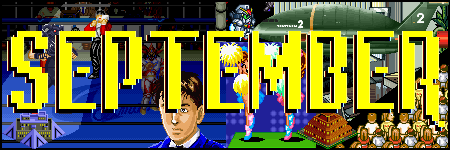
- List of releases: 31
- US Block: 16
- Japan Block: 15
- List of Super Famicom exclusives: 12
SNES highlights: It's full steam ahead as Autumn begins and games start coming out again. The US Block is back in force, outnumbering the Japan Block once more.
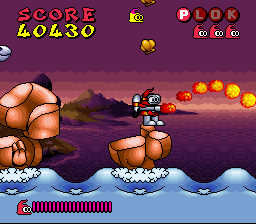
My favorite of this bunch is Plok, a hero that throws out his limbs to hit enemies making him somewhat vulnerable if he misses. The game's quite challenging, in spite of its colorful and comedic countenance. It also sports one of the best soundtracks of any Super Nintendo game, created by the Follins brothers using every trick in their repertoire to get the most out of the SNES's SPC-700 sound chip. It's really gotta be heard to be believed.
Honorable mentions: I suppose I ought to mention Mortal Kombat, even if no-one particularly cared for the sanitized Super Nintendo version. Instead, the next best game by a very close margin is Zombies Ate My Neighbors, the LucasArts top-down shooter that had more B-movie charm than it knew what to do with. Third spot goes to, appropriately enough, the surprisingly decent advergame Cool Spot, devised by the folks who would go on to create Shiny Entertainment and the Earthworm Jim series.
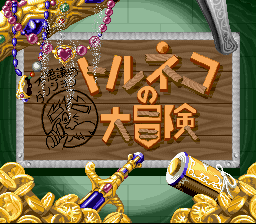
SFC highlights: Hmm, tough call. For historical reasons, I'm putting forward Torneko no Daibouken: Fushigi no Dungeon, a.k.a. Torneko's Great Adventure: Mystery Dungeon. As in, the first ever Mystery Dungeon game. Torneko's a portly gentleman who became my favorite character in Dragon Quest IV's roster: a merchant who would frequently rip off his customers with items he found after beating up monsters. Fushigi no Dungeon continues his avaricious adventures, hunting deep below the Earth for valuable treasures to fleece people with.
Honorable mentions: The awesomely-titled Kachou Shima Kousaku: Super Business Adventure is an otherwise dry multiple-choice visual novel where you have to make the best life decisions for a milquetoast salaryman. GS Mikami: Joreishi wa Nice Body is an interesting supernatural platformer based on a comedy anime about a wealth-obsessed exorcist. Gerry Anderson's Thunderbirds: Kokusai Kyuujotai Juudou Seyo!! is curious for being a Japan-only adaptation of a popular British marionette TV show, like Team America played straight (and with less collateral damage to landmarks and actors).
October
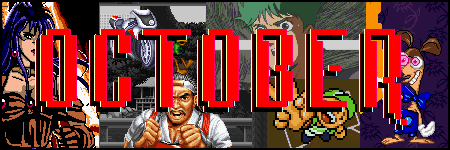
- List of releases: 34
- US Block: 18
- Japan Block: 16
- List of Super Famicom exclusives: 13
SNES highlights: It's going to continue to get more serious as we move on, as more and more games are pushed out to meet the Holiday demand. Unsurprisingly, there's a few good ones here.
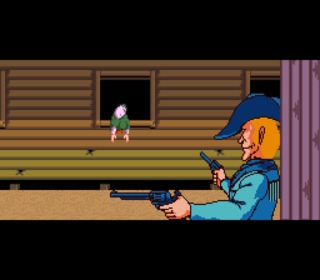
Sunset Riders, the Arcade game Jeff Gerstmann pined for up until the very end of Game Room, is a fun Konami shooter that got a fairly solid conversion for the Super Nintendo. It sadly lacks the four players of the original cabinet, but it's almost identical sound and graphics-wise. Well, besides all the customary Nintendo censoring. I remember loving many Konami Arcade games and being sad that their home versions never quite measured up, but Sunset Riders is one of the few they got right.
Honorable mentions: Some other excellent games from this month include Pac-Attack, a Tetris-like puzzle game based on another game that had characters that weren't going to be very recognizable to Western audiences (like the similarly westernized Dr Robotnik's Mean Bean Machine). This month also saw a spate of EA Sports stuff, including NHL '94 and Madden NFL '94, back when EA were pretty much ruling the school for licensed sports games. Another honorable mention is Super Star Wars: The Empire Strikes Back. I loved the sound quality in that series, even though I rarely survived the initial Hoth stage in this one. At least the first Super Star Wars had a grace period before dropping all the impossible jumping sequences on you.
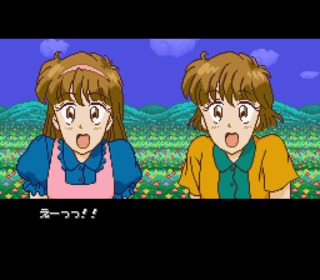
SFC highlights: I'm just going to start listing weird stuff, since I didn't play any of these long enough to pick a clear winner. Miracle Girls is a very saccharine platformer that plays similarly to Little Nemo: The Dream Master for the NES, right down to stunning enemies with candies.
Ranma 1/2: Akanekodan Teki Hihou is a rare Ranma 1/2 game that isn't a fighter, like Hard Battle, but rather an RPG. Super Chinese World 2: Uchuu Ichibuto Daikai is the Japan-only sequel to Super Ninja Boy, and continues that series' bizarre sense of humor and kung fu action albeit as a fighter game rather than a brawler.
November
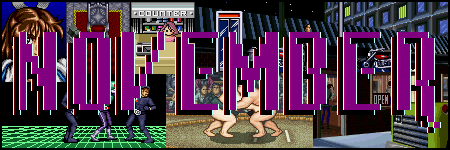
- List of releases: 42
- US Block: 16
- Japan Block: 26
- List of Super Famicom exclusives: 15
SNES highlights: It's going to get harder and harder to narrow down highlights as we see more and more releases as 1993 closes out. This month in particular has two games very close to my heart.
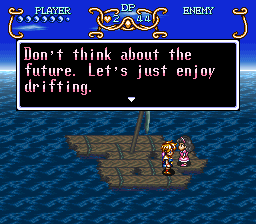
I'm going to have to say Illusion of Gaia is my pick for this month. The second game in Quintet's Soul Blazer series, Illusion of Gaia is a simplified but certainly not easy action RPG that superficially resembles The Legend of Zelda with its overhead view and puzzle-filled dungeons. It also has a gonzo story, sending the party (though you only ever play as Will and his two badass transformations) across the world to search for mystical statues needed to defeat an evil comet. All the dungeons in the game are based on famous landmarks, like the Wall of China and Angkor Wat. It's one of those games I wish I could show off to more people, maybe in the form of an LP. Ah, if only I had the video editing means. I'm sure other LPs of it exist.
Honorable mentions: Equinox was my second choice, an isometric puzzle-platformer styled like the C64 games that eventually made Rare a household name. Equinox is another game like Plok that was fortunate enough to be scored by the Follins brothers, and although it's mostly ambient music it still sounds phenomenal. Disney's Aladdin is another easy choice, as one of those rare movie licenses that had some talented folk behind it who actually gave a (street) rat's ass about the source material. I'll throw Patrick a brachiosaur bone with my final choice of Jurassic Park. It's perhaps not as good as the Genesis take (a similar case could be made for Aladdin, though I can go either way on that one), but the SNES version is curious for its inclusion of Doom-style first-person indoor sections.
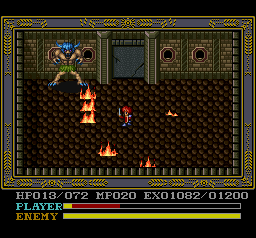
SFC highlights: Well, let's see. I think a good choice would be Ys IV: Mask of the Sun. The Ys games are generally fantastic, and it's a shame IV and V were never localized at the time. Ys IV in particular has an interesting history, in that it's actually one of three Ys games with that numeral: Ys IV: Dawn of Ys shares the same story but plays very differently, and was released by Hudson for the Turbo CD (or the PC Engine equivalent, at least). Both games were replaced canonically with the recent third iteration, Ys IV: Memories of Celceta, which can be bought in the US and Europe for the PS Vita (and, hopefully soon, on Steam). Many accounts seem to suggest that MoC is the best Ys game made thus far.
Honorable mentions: There's Accele Brid, which is an unusual mech shooter where you fly through tunnels. The tube shooter wasn't really a thing on 16-bit consoles, since they couldn't pull off the necessary sprite-scaling technique at a sufficient speed (something that plagued every home console port of Space Harrier for the longest time). It was deemed good enough to get an Aeon Genesis fan translation, so it can't be all bad. There's also Super Uno, which is just Uno but kinda super? Seems very odd indeed that it was never localized. Maybe the developers didn't think it would sell overseas without webcam support? Rounding out the trio is Aretha, because I giggled at the name like a child. I know, I know, Aretha Franklin is (was? is) a person and the name actually means "virtue" in Greek. Still a child. The game itself doesn't seem too bad either, though it's more straightforward fantasy JRPG stuff. It has a female protagonist at least, which was (and still is) somewhat unusual. Weirdly enough, she's not called Aretha.
December
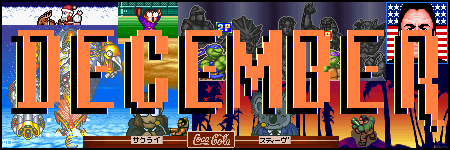
- List of releases: 55
- US Block: 12
- Japan Block: 43
- List of Super Famicom exclusives: 32
SNES highlights: December's launch schedule is just ludicrous. Fifty-five new releases in a single month, more than double of most of the others. It's not even the US that's responsible this time in their mad dash to find likely candidates for Christmas presents, as the vast majority are from Japan who don't even do the whole presents thing at Christmas as far as I'm aware. It's more like Valentine's Day for them from what I gather from all my Japanese animes. With cake. It's... look, I admire they found some way to make it fun that didn't involve carols and spending too much money.
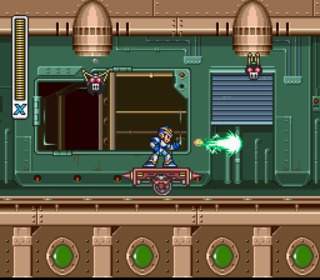
As for the SNES highlight, we're really spoiled for choice here. However, realistically, I don't think there's any beating Mega Man X. I didn't get into the Mega Man X series at the time, but there's no denying the amount of craft in those games. The soundtrack's amazing too, easily one of the best in the entire Mega Man franchise, which is saying something.
Honorable mentions: Metal Combat: Falcon's Revenge is worthy of mention for being a superior sequel to Battle Clash, which had been up to that point the only reason to buy a Super Scope. TMNT Tournament Fighters is beloved to a certain group of weirdos too, but there's definitely something appealing about playing out your "which Turtle is better?" arguments in a fighter game with a bunch of odd comic book-only characters to round out a supporting cast. I'll give the last slot to a curiosity pick: Firestriker, a title that possibly inspired Wizorb with its odd merging of an RPG and an Arkanoid "bat and ball" game.
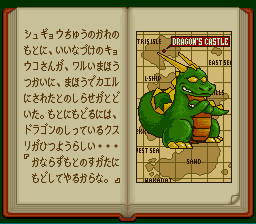
SFC highlights: Though there's thirty two games to choose from, there's only one real choice: Battle Tetris Gaiden. The only SFC game that can compete with Sanrio World Smash Ball! for the affections of the Giant Bomb audience. What to know something interesting about this one? There's a way to play as the two boss characters with a simple button sequence on the character selection screen. From what I've heard, they're both even more unbalanced than Ninja Kid. It's only a matter of time until one of the crew figures out how to access them...
Honorable mentions: Well, I guess there's no denying the influence of Super Puyo Puyo. Though not the first Puyo Puyo incarnation, it would be the one to inspire many spin-offs, including Mean Bean Machine and Kirby's Avalanche. Ganbare Goemon 2: Kiteretsu Shogun Magginesu is the SFC-only sequel to The Legend of Mystical Ninja (one of my favorite SNES games) and not only has a plot similar to the N64 Mystical Ninja Starring Goemon (one of my favorite N64 games) but also introduces Goemon's giant robot doppelganger Impact to the series. Dolucky no Kusayakiu is my pick for "what the hell, Japan?": a baseball game populated entirely by Coca Cola soft drink mascots, represented as anthropomorphized animals. In fact, because this month was so busy, here's two more honorable mentions: Zoku: The Legend of Bishin is another Mad Max-inspired post-apocalyptic vehicular combat-slash-brawler, though with the added twist that all the antagonists are tough female bikers. Kessen! Dokapon Okukoku IV: Densetsu no Yuusha Tachi is historically notable for being the very first Dokapon game, which are combination RPGs-board games, similar to Monopoly. The "IV" in its title refers to the number of human players it supports.
Unknown
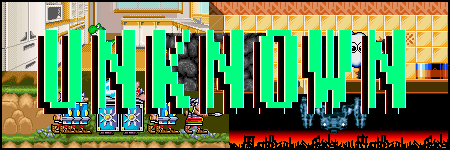
- List of releases: 7
- List of Super Famicom exclusives: 1
SNES highlights: Welcome to the bonus zone. These seven games don't seem to have any specific release data; I only know that they came out some time in 1993. This is largely the fault of Europe, which didn't seem to keep records of any of their release dates (possibly because EFIGS translations meant games would be brought out in different countries within the PAL region over a period longer than a month). There's only six recorded Europe-premiering games, five of which are exclusive to the region.
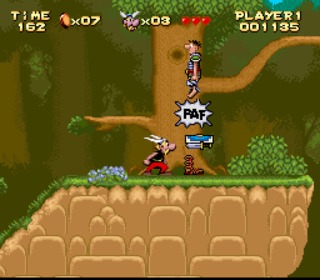
The highlight? Well, I'd probably go with the SNES Asterix. It's a fairly solid platformer that wasn't released in the US because the indomitable Gaul doesn't have much of a presence there, but that's no mark against its quality.
Honorable mentions: Aren't too many of these. The Humans is a fairly fun puzzle game in the vein of The Lost Vikings or Lemmings, where you use your barely evolved cavemen to look for new inventions to further their intellectual growth. Might and Magic II is actually one of two Might and Magic II games released that year, one exclusive to Europe and one exclusive to Japan. (From what I've played, Japan's seems the more fun. They actually upgraded it.) Super Morph is another puzzle game, one that has you switching forms to get through a laboratory. It's kinda reminiscent of the many Indie puzzle-platformers you see on Steam today, like Puddle or Element4l.

SFC highlights: Well, let's see, there's only one Super Famicom game without a definite date. That would be Yoshi no Cookie: Kuruppon Oven de Cookie. It's not quite a sequel to Yoshi's Cookie, but rather a remake that added a whole bunch of advergame stuff about Panasonic's Kuruppon Oven, including how to use your Kuruppon Oven and what to cook in your Kuruppon Oven. Weird stuff. It's also super rare, as only 500 copies were ever made. Needless to say, copies tend to fetch crazy high prices.
What's even weirder is that it's not even the only product-placement cookery advergame from Nintendo in 1993 either: Motoko-chan's Wonder Kitchen also came out that year. It's another game that teaches you how to cook delicious food with lots of close-up images. Like, did Japanese people have their Super Famicoms hooked up in their kitchens?
Anyway, that is the end of this little adventure to the misty pasts of 1993. The Super Nintendo would see even greater peaks in 1994 and 1995, before the success of Sony's PlayStation overshadowed it and Nintendo refocused most of their efforts on the Nintendo 64. As for future Wiki Projects of mine, I think I'll go for something a little less ambitious before moving onto the next year for Super Nintendo. I could do with a breather, honestly.
As could you all after reading this far. Thanks for checking out this monster of a war journal from the wiki frontlines and I'll catch you all later. (Octurbo's only a week away...)
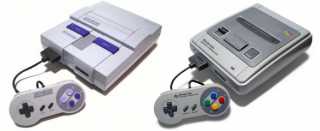
Log in to comment